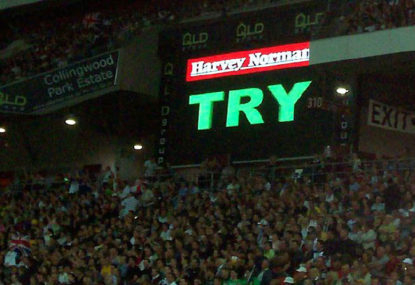Being an on-field referee is becoming a near impossible task.
Referees, in the traditional sense, are being made redundant on the field, as more and more decisions are being taken upstairs.
NFL, cricket, AFL, rugby league, tennis. The TMO has infiltrated most of our most popular sports over the last few years as technology has advanced, with varying effectiveness and fan reception.
And there has not been a clearer indication of a negative response than in the Rugby World Cup over the last couple of weeks.
A raft of games have been affected by use of the TMO, including England versus Fiji. Referee Jaco Peyper referred six decisions to the TMO – most of which were conceivably avoidable – detrimentally impacting both the occasion and flow of the match.
In the World Cup opener, the issue clearly stemmed from Peyper missing Fijian scrum-half Nikola Matawalu dropping the ball over the line – initially awarding a try only to reverse the decision moments later when the Twickenham crowed roared in disbelief when shown the dropped ball on the big screen.
From that point on, the South African’s confidence was destroyed, and numerous delays ensued while he repeatedly checked with his TMO over decisions that – as one of the top referees in game – he should have been able to make a call.
The delays have been so commented upon that World Rugby moved to released a statement sensationally going as far as to highlight that just 28 per cent of the stoppages in the opening game between Fiji and England were due to the TMO. Despite this being the case, impressions are everything, and the perception was that this was 28 per cent to much.
When Australian rugby legend Michael Lynagh waded into the debate with “It’s taking too long, it’s the process that’s wrong”, he hit the nail on the head.
The delays had Twickenham grumbling with a palpable sense of frustration even more so than England’s disjointed display.
Additionally, constant delays while staring at the stadium big screen is not an uncommon scenario for fans of rugby league.
Since being introduced in 1996, the TMO has evolved into the default option for referees for the most basic decisions, delivered to the fans with a hint of sponsorship chicken.
In Fridays NRL preliminary finals the TMO was also called upon on six occasions at Lang Park in the Broncos versus Roosters game, while the Storm versus Cowboys match warranted seven interventions.
When the TMO was called upon to disallow a Brisbane try as Corey Oats’ foot slid into touch, the ponderously deliberated replay showed the touch judge in the perfect position to make a call.
So why didn’t he?
The question was justifiably raised. If the touch judge is not going to do his job, then why is he there? Surely not just to wave his flag when the ball goes dead?
The near-constant use of the TMO in the NRL serves to give the impression that the referees are paralysed by fear. The fear of making the wrong call. The fear of spoiling the spectacle by sending a player off for foul play. It’s a fear that permeates and influences every decision the man (or men) in the middle makes.
So what does the future hold? If touch judges are unwilling to make a call, perhaps there is no need for them?
American sports have been long used to the TMO. The NFL is the undisputed king, with the entire game sculpted around television demands and capabilities.
With seven officials on the field in addition to a ‘replay official’ in the bunker in New York, the fallibility of referees is highlighted while paradoxically more are visibly utilised. It is a perfect showing of how technology can be allied to existing procedures.
In NFL, the TMO is called upon either by coaches challenges (two per game) and the ability of the TMO to ‘buzz’ the on-field official if a questionable play is called.
Because the video referee is watching the game – from a multitude of angles – the whole time, there is limited delay in the decision being made. This is something the NRL and Rugby World Cup would do well to investigate.
However the inevitable delays blend in as part of the punctuated nature of American Football, and although this has crept into rugby league, I’d wager its inclusion in union will be pointedly resisted.
As the TMO evolves, I think a coach challenge could be a good option.
For a start, the referee is still utilised fully, the human element for most decisions is maintained, and absolute howlers can be eliminated.
As the money in sport ever increases – and technology improves – all sports are having to face the challenge of adapting to the increased scrutiny and ability of the men in the middle. Yet despite the temptation to march down a path of eliminating errors completely, to maintain the integrity of sport, the on-field official has to be allowed to do his job – and in doing so, the odd mistake will be made.
The alternative is almost beyond imagination.
Are we looking at a future where rugby matches of either code are reduced to 60 minutes playing time in order to fit all the delays in challenging and checking every single decision into a manageable block for TV.
And yet the current situation cannot be allowed to continue either. The constant erosion of the on-field referees authority has reached epidemic proportions and at least a part of that is due to their own unwillingness to make a call.
Sport is a game, and regardless of the importance of that ‘key’ decision, mistakes will be made. Rather than eliminate the referee completely, we should embrace and commend their impressive skills to the full. Allow the officials to regain the respect they’ve lost and be accepting of the occasional mistake.
Either that or start blocking out significantly more of your Saturday for the footy.





























































































